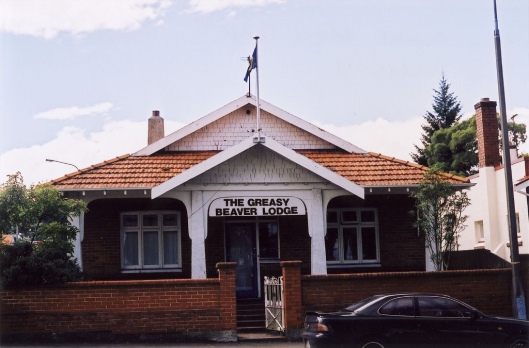From the “Bach” of the 1930s to “Gran’s Place” of the 2010s, Otago students have developed quite a tradition of naming their flats. For the past ten years or so, Sarah Gallagher has been recording and researching this phenomenon, and has a book about it planned. Sarah, who is a librarian at the Health Sciences Library in her other life, runs a blog, a facebook page and a twitter account about the Dunedin Flat Names Project, and you can read much more about it there.
Sarah says that the naming of flats, though not peculiar to Dunedin, doesn’t occur on such a large scale anywhere else in New Zealand. Perhaps it is a self-perpetuating phenomenon! Some names have persisted for decades, while others come and go and their origins have been lost.
The Bach, at 208 Leith Street, was established by a group of bachelor divinity students in the 1930s. Flatting was rare in that period, and students from out of town who couldn’t afford to live in a residential college generally lived in some sort of boarding situation, often a cheap room provided by a local landlady. The Bach provided a home to some university students alongside men studying at the Presbyterian Theological Hall, Knox College. It was a well organised community, but it was pretty crowded, with a dozen or so people squashed in three to a bedroom. It had a name plate, and also a crest and Greek motto, which translates to “because of poverty”.
As flatting became more common in the 1950s and 1960s, new flat names appeared on the scene. As remains the case today, some of these reflected the standard of the accommodation or the lifestyle of the residents. The Shambles was a well-known 1950s and 1960s party flat on the corner of St David and Great King Streets, where Scribes Bookshop is today. Among the many named flats of the 1970s were the Hobbit’s Hovel, the Slagg Heep (158 Dundas Street) and the Spanish Slum (16-18 London Street). In the 1990s Sarah herself lived in the Mouse House (888 Cumberland Street), a rundown flat so named because of all its vermin. The Shit House Chateau (47 London Street) was voted the worst flat in Dunedin in the students’ association’s 2012 awards. In an innovative project, the Chateau (as the Otago Daily Times politely names it), was rented by a group of students belonging to environmental group Generation Zero in 2013. Their goal was to tidy up the house and turn it into a healthy home as an inspiration to both landlords and students.
Of course, not all Dunedin student flats are rundown dives and there are many modern or renovated places on the rental market. But it is the older “character” buildings that tend to attract names. Many include subtle, or not so subtle, sexual references, such as the Cock and Swallow, while some refer to drinking exploits, such as the DSIR (Department of Student Inebriation Research). Others are more cultural or esoteric in origin. Pink Flat The Door at 3 Clyde Street, named in 1988 by a group of students including broadcaster Wallace Chapman, was a “freedom flat” inspired by Skinner’s philosophy of a free society. The door design refers to Pink Floyd’s classic album The Wall. Some names reflect the history of the building. From the late 1990s comes Bruce’s Beenjamin’ Butchery, located at 15 Ethel Benjamin Place and clearly visible from State Highway 1. The house used to be a butcher’s shop, and Bruce was the landlord. Others reflect the identity of the flatmates. The house at 40 Dundas Street, once upon a time known as the Greasy Beaver Lodge, has recently become the Embassy, complete with Samoan flag.
Ironically, one of today’s most famous Otago flats has no name. In 2006 a group of friends from Unicol moved into a flat at 660 Castle Street and became known as “the boys from 660”. When the band they formed made its first recording and needed a name, they selected Six60. The band has since gone on to great success, and recently returned to Otago to perform at 2014 orientation, attracting what is claimed as the biggest crowd in O-week history.
Sarah’s project is clearly shedding new light on the fascinating cultural history of Otago student life. Have you got any stories of named flats to share, either with her or here?







